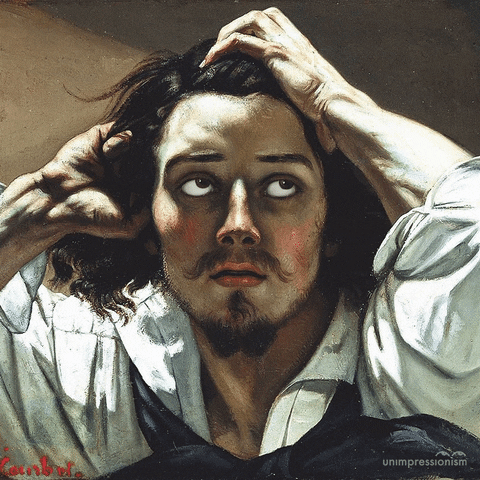 via unimpressionism
via unimpressionism
Realism can refer to two things: the representation of the subject as it appears in real life or the 19th-century movement that began in France after the 1848 Revolution. The first definition of realism is interchangeable with the word naturalism and refers to the illusionistic realism that seeks to mimic real life, presenting the physical appearance of the subject accurately. The latter focuses instead on the content of the subject matter, choosing to capture a truthful vision of modern life, portraying the mundane (or ugly and grotesque as labeled by its critics).
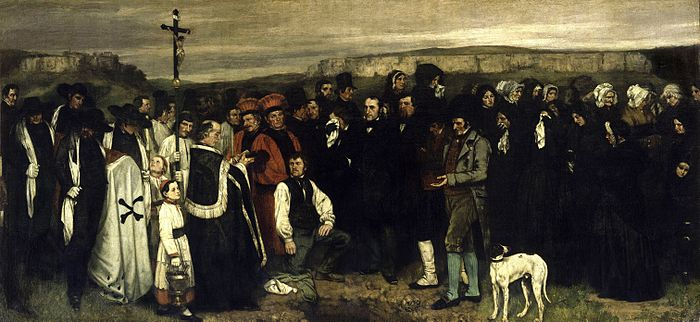
Gustave Courbet, A Burial at Ornans, 1849-50
This painting by Gustave Courbet may just look like another painting of some bereaved French people, but it caused quite a scandal during its exhibition at the Salon of 1851. This painting depicts a funeral, a subject normally reserved for kings and popes, lifting an everyday village scene to a level of grandeur and nobility. Critics also attacked this painting simultaneously for being unrealistically flat and also too realistic in its depiction of the townspeople, capturing every wrinkle and unbecoming detail in their facial expressions.
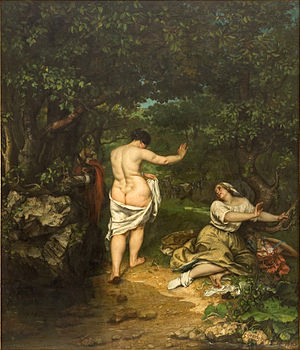
Courbet, The Bathers, 1853
This line of simultaneously unidealized, yet too realistic criticism followed Courbet into his later paintings, including The Bathers and The Stonebreakers. The banality of his paintings alienated the public, yet his too realistic nudes were seen as indecent. The painting, The Bathers, was criticized for its too credible butt and sketchy landscape.
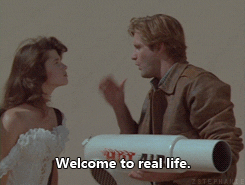 Despite unanimous disapproval by critics, this painting was bought for 3,000 francs by wealthy art collector and trust fund baby Albert Bruyas, allowing Courbet to be financially independent and thus began his period of radical realism and Realist manifesto of 1855.
Despite unanimous disapproval by critics, this painting was bought for 3,000 francs by wealthy art collector and trust fund baby Albert Bruyas, allowing Courbet to be financially independent and thus began his period of radical realism and Realist manifesto of 1855.
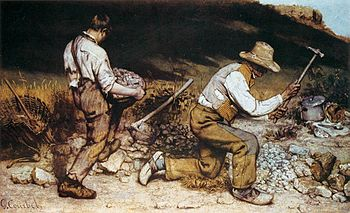
Courbet, The Stonebreakers, 1849-50
Courbet focused his art on subjects that were often ignored or obscured by the privileged, capturing social relations during a time of charged political circumstances. Although his focus was capturing truth, reality is subjective in art, and like the idealized mimetic realism, his art was curated for the eyes of the viewer. Courbet refuses to sentimentalize the stonebreakers, a common job in rural areas during the off-season when extra income was needed, a “make-work” activity, or form of unskilled labor designed to prevent the canaille (the masses) from pillaging towns and becoming “idlers.” Courbet records this activity unburdened by bourgeois prejudice, bringing to the issues caused by urbanization to the center of the canvas. Although Courbet presented paintings of real people instead of the idealized forms prescribed by the Academy, his art was no less curated. Designed to touch the conscience of the viewer, realist ambition is to convert a political ideology into aesthetics.
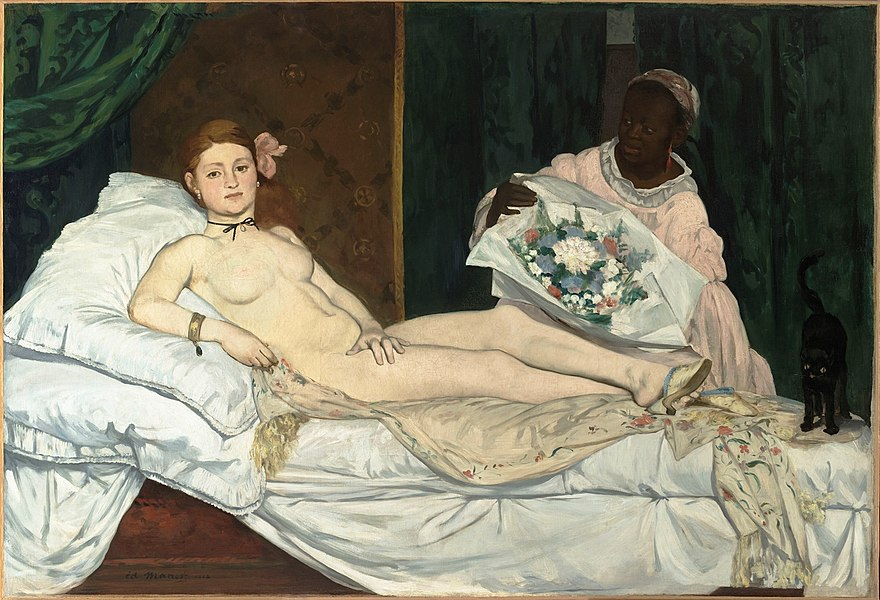
Edouard Manet, Olympia, 1863
Another artist who is associated with the Realism movement is Edouard Manet. Like Courbet, his paintings were also a form of social critique. The painting Olympia was first shown at the Salon of 1865, where it caused quite a scandal. Its composition mimics the quintessential nude, Titian’s Venus of Urbino, except here Olympia is not a demure nude goddess but a naked prostitute. The name “Olympia” signaled her occupation, as well as the orchid in her hair, the bracelet, and her earrings as a symbol of wealth and sensuality. In the back there is a cat instead of a dog, again signaling her occupation rather than fidelity. Manet, in his frank portrayal, presents Olympia instead of idealizing her, and with it, the social changes happening in the newly modernized Paris.
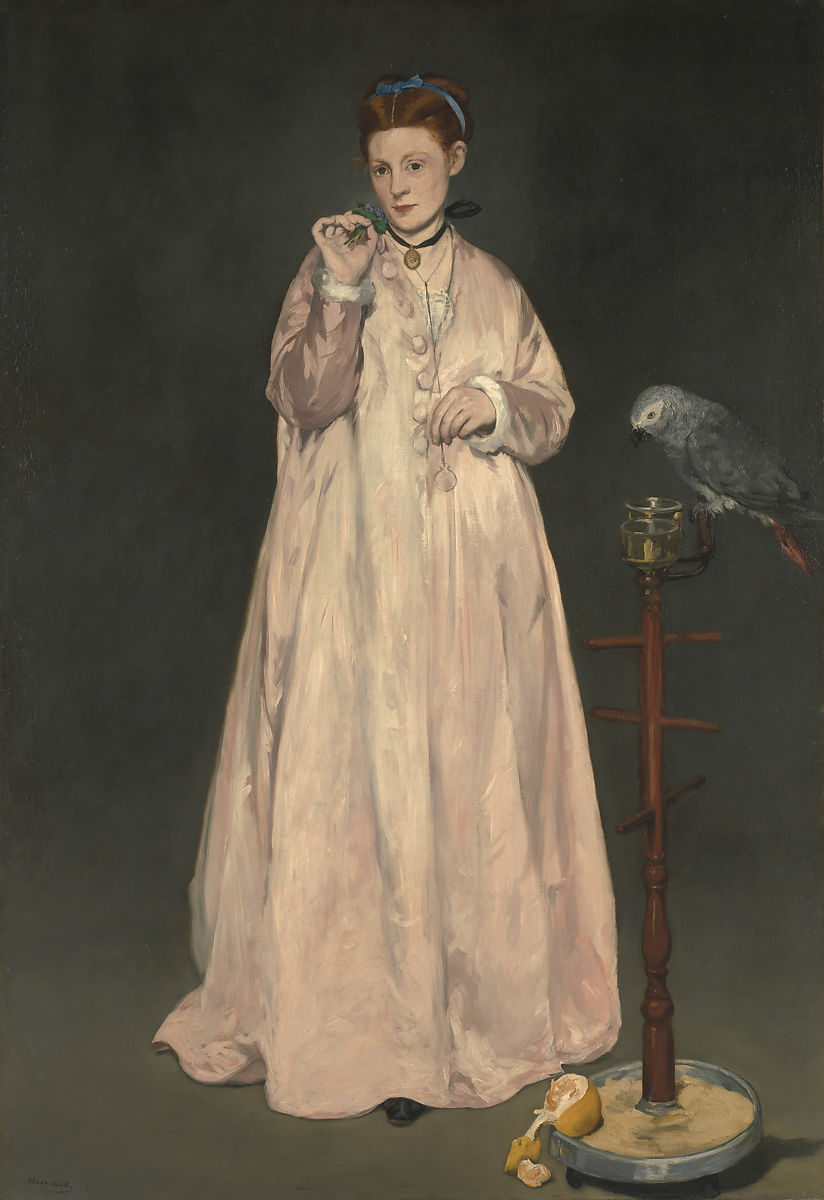
Manet, Young Lady in 1866, 1866
Manet’s paintings were often criticized for lack of clarity, both in the quick brushstrokes, a precursor to Impressionism, and the lack of narrative. At the time, the Academie des Beaux-Arts, or the governing body of art education in France, had strict guidelines for how painting should be conducted, developed by Nicolas Poussin, advocate of academic art and avid rulemaker. This included guidelines for subject matter, which had to be classical or biblical. Manet chose to paint everyday life–rural and urban workers, streets, cafes and nightclubs. This confused the academicians who had four strict genres–history, portraiture, genre, landscape and still life.
The painting Young Lady in 1866 fell into multiple categories. The most apparent is portraiture, although her casual dressing gown, or deshabille, and lack of insight into her personality would classify it otherwise. Some speculate that it is an allegory of the five senses, the nosegay representing smell, the orange for taste, the parrot for hearing or confidence, and her fingers on the monocle alluding to touch and sight, which could make it a history painting. However, the woman is not recognizable as an allegorical figure, perhaps classifying it as a genre scene. The critics, fixated on the social constructs of academic painting, were no doubt puzzled, leading to boiling hot burns like comparing it to a still life, the lowest genre of painting, and tepid burns like calling it a “daub”.

Realism was partially possible due to the changes that it critiqued. Modernization created a new class of bourgeois art buyers who were unconcerned with the academic traditions and guidelines set for art. Realists worked both against the bourgeois and for the bourgeois audience, provoking them with aesthetics that opposed the existing conventions. Demand for art grew, as did tensions between bourgeois buyers and academicians, and pressure to accept more canvasses led to the establishment of the Salon de Refusees, made up of paintings that didn’t quite make it into the actual Salon. Diminished by critics for not having seriousness or worth, these images of subjects previously ignored were able to speak to the changing art market and the tastes of the middle class. Additional artists worth mentioning in the Realism movement include Jean-François Millet, Honoré Daumier, and Jean-Baptiste-Camille Corot.
Sources
- Boime, Albert. Art in the Age of Civil Struggle. (Chicago: University of Chicago Press, 2008).
- Buchon, Max. “On Courbet’s Stonebreakers and Burial at Ornans”. In Art in Theory. Edited by Charles Harrison and Paul Wood, 364-366. Oxford: Blackwells, 1998.
- Finocchio, Ross. “Nineteenth-Century French Realism.” In Heilbrunn Timeline of Art History. http://www.metmuseum.org/toah/hd/rlsm/hd_rlsm.htm.
- Arden Reed, Manet, Flaubert, and the Emergence of Modernism (Cambridge: Cambridge University Press, 2012).












For me, realism is one of the most interesting styles that I started learning in high school.